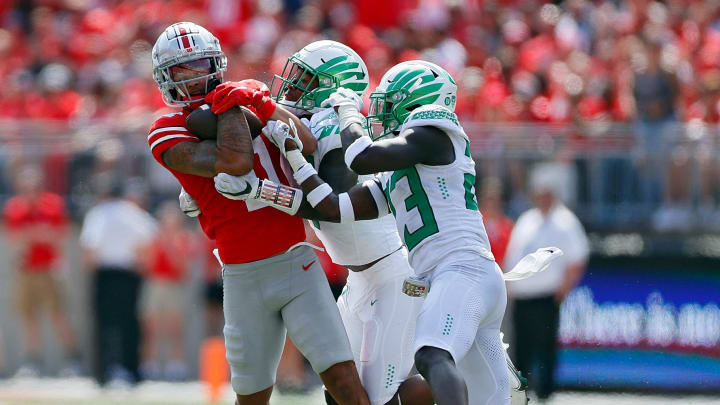Big Ten Releases 2024–28 Football Schedules As It Preps for 18-Team Future

In this story:
The Big Ten rolled out its football schedules from 2024–28 Thursday, a radical revision of the previous slate that came out in the summer due to the inclusion of Oregon and Washington. With four schools now on the West Coast and 18 total members, the conference is working an ambitious juggling act of travel demands, rivalry retention and competitive balance.
Among the four West Coast schools, the most difficult 2024 challenge from a geography standpoint falls to Washington. The Huskies will play five conference road games total, four of them off the West Coast, including Eastern time zone trips to Penn State and Rutgers. USC is playing five road games, but two of them are on the West Coast, against UCLA and Washington. Oregon and UCLA are playing four road games, three of them away from the West Coast. The Trojans and Bruins also are making two trips to play in the Eastern time zone.
Big Ten officials said on a Zoom call Thursday that they examined 262 total schedule models before settling on this one. The league maintained the “flex protect” model it introduced in June, adding one annual protected rivalry to the list in Oregon vs. Washington. The others remain the same: Illinois-Northwestern, Illinois-Purdue, Indiana-Purdue, Iowa-Minnesota, Iowa-Nebraska, Iowa-Wisconsin, Maryland-Rutgers, Michigan–Michigan State, Michigan–Ohio State, Minnesota-Wisconsin and UCLA-USC.
In total, the Big Ten scheduled 405 games over the next five years. Although the league “reset the deck,” in the words of chief operating officer Kerry Kenny, there are no repeat matchups in the same location from this year’s schedule.
“The core concepts are still in place here,” said Big Ten commissioner Tony Petitti. “We feel really good about where we landed.”
Kenny described the process as “a whirlwind eight weeks” of working with the schools and scheduling consultant Kevin Pauga once Oregon and Washington joined the league in early August. Without delving into specifics, Kenny said from a competitive balance standpoint, they split the league into two groups of nine, then three groups of six, and finally six groups of three.
“We went right to work, knowing we didn’t really have the benefit of time,” Kenny said. “But we did have a model in place. We wanted to make sure we showed our work this time.”
Added Pauga: “For the better part of eight weeks, the computer was running in some form or fashion.”
One element that was discussed and ultimately shelved: whether the four new schools should all play each other annually. Kenny said that the conference concluded that accelerating the integration of the new programs into the league was “to play each other more, not less.” In other words, scheduling one-third of their conference games against each other slows the process of the West Coast schools playing everyone else, getting to all those campuses and having the established Big Ten teams come to their campuses.
The devil will now come in the details: creating a week-to-week, home-and-away schedule grid that takes into account the extraordinary travel demands and greater competition with the addition of four currently successful Pac-12 programs. Kenny said he and Pauga have a call to discuss those next steps scheduled Friday, and they hope to have the more detailed schedules in front of Big Ten athletic directors by the end of this month. Those details likely would not be released publicly until later.
“If you asked our athletic directors, they’d say, ‘We need that schedule yesterday,’“ Kenny said. “We’ve been building this model in the background.”
He added that they have been looking at “pain points” that can be avoided if possible. The 2024 scheduling will be aided, he points out, by the presence of two open dates built into the calendar.
Petitti acknowledged that while competitive fairness to each member was paramount, the league also is trying to build schedules that will enhance the number of bids it can earn in the 12-team College Football Playoff that debuts next year. Part of that will be lobbying for strength of schedule to matter even more than it has in years past.
“We have to make sure strength of schedule is at the very top of the selection process,” Petitti said.
Full 2024–28 Big Ten schedules below:

Pat Forde is a senior writer for Sports Illustrated who covers college football and college basketball as well as the Olympics and horse racing. He cohosts the College Football Enquirer podcast and is a football analyst on the Big Ten Network. He previously worked for Yahoo Sports, ESPN and The (Louisville) Courier-Journal. Forde has won 28 Associated Press Sports Editors writing contest awards, has been published three times in the Best American Sports Writing book series, and was nominated for the 1990 Pulitzer Prize. A past president of the U.S. Basketball Writers Association and member of the Football Writers Association of America, he lives in Louisville with his wife. They have three children, all of whom were collegiate swimmers.
Follow ByPatForde